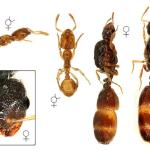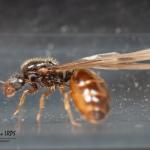Aptly named a ‘thief ant’, S. fugax preys on the brood of larger ants. It is seldom seen above ground.The aggressive yellow or brownish-yellow workers are small (1.5-3.0mm long), but the blackish brown females and black males are considerably larger (6.0-6.5mm and 4.0-4.8mm, respectively) (Collingwood 1979). S. fugax is the sole representative of its genus in Britain.
Solenopsis fugax is found throughout Europe as far north as southern England and south Sweden. Except for the sheltered Goblin Combe in Somerset, all known English and Channel Islands sites are coastal. The species’ known range extends beyond Europe to north west Africa, the Caucasus, Middle East, Asia Minor and Central Asia, and the southern part of Western Siberia (Czechowski, Radchenko & Czechowska, 2002).
Listed as Rare in Shirt (1987) and by Falk (1991), and only recorded from three English hectads since 1969. However, its subterranean habit makes S. fugax easy to overlook, and the species probably persists at most, if not all, previously recorded sites.
Colonises warm, dry, open sites with sparse vegetation. Nests occur in the soil (often deep in the ground), in rock clefts, or under large stones.
Winged males and females may be present in the nest in August, but mating flights occur during warm afternoons in September and October.
Nests are frequently found in close association with those of larger ants such as Lasius and Formica species. Isolated nests are uncommon. Colonies are populous, with up to 100,000 workers and several queens. Workers lack functional ovaries. Therefore, unlike the workers of many other ant genera, they cannot produce males. New nests may be founded claustrally (i.e. with the queen rearing her first brood in isolation), or by nest budding (Seifert 1996).
Solenopsis fugax eats the larvae and pupae of other ants and also tends root aphids. Workers steal brood from the nest of a larger ant via tunnels connecting their nest with that of their host.These tunnels are too small for the host workers to enter. During raids, S. fugax workers prevent the hosts from defending their brood by discharging an effective and long-lasting repellant from their poison glands.
In mainland Europe S. fugax is one of the ant species known to be parasitised by the fungus Myrmicinosporidium durum Hölldobler (Buschinger et al. 2004).
2020



